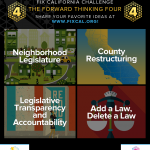 The last few years have seen a growing number of attempts to involve people more in the process of government, whether it’s looking for ideas (as Obama and the Labour party have), participatory budgeting or even civic co-creation, there are no shortage of attempts to tap into the power of the crowd.
The last few years have seen a growing number of attempts to involve people more in the process of government, whether it’s looking for ideas (as Obama and the Labour party have), participatory budgeting or even civic co-creation, there are no shortage of attempts to tap into the power of the crowd.
Indeed, innovation charity NESTA predicted that 2014 would be the year when politics became crowdsourced, with the likes of IBM and Deloitte all producing reports on the topic.
There is perhaps no greater challenge than fixing the rather disjointed government of California, but that hasn’t stopped the noted Silicon Valley entrepreneur Tim Draper from trying.
The Fix California Challenge
The Fix California Challenge recently announced the four finalists in its crowdsourced challenge to help improve the governance in the sunshine state.
The Californian competition is the first event from the Innovate Your State set up by Draper to help foster greater engagement in government by citizens.
“I came up with the ‘Fixcal Challenge’ to give you Californians the opportunity to crowdsource yours ideas, bring them to me, and see if there was something there that was more important than anything else that could really change California for the better,” Draper says. “You have responded in a big way.”
The challenge attracted over 400 ideas, which have been whittled down to the final four by the judging panel. The four ideas are:
- Neighborhood legislative reform act, which aims to limit the number of citizens each legislator may represent
- The public’s right to know act, which aims to ensure the legislature abides by the same transparency rules that they expect everyone else in the state to
- Add a law, delete a law, which suggests that for each new law that is added, one must also be removed
- County restructuring, which proposes to streamline governance by merging counties into much larger units
Interestingly, if you look at the number of votes received for each idea, two things stand out. Firstly, the number of votes is pretty small, especially for a state the size of California. Secondly, some of the finalists were more unpopular than they were popular. The county restructuring proposal, for instance, was the second most unpopular idea submitted.
It would appear, therefore, that the crowd only had a limited input into the relative success of the various ideas. There is also a degree of uncertainty about just what happens after a finalist is selected.
There may be financial remuneration, there may not, it’s all a little bit fuzzy. I’m not overwhelmingly confident that the challenge has created sufficient groundswell to change something as immobile as the Californian legislature, but commend Draper for at least making the effort.
You can listen to Draper discussing each of the four finalists below
I commend the effort, but government there seems so utterly broken that I'm not sure this project has a hope of making a dent.
It's always good to get people involved in government, but I wonder how involved are the people who are actually going to change? Are they having these solutions imposed upon them?